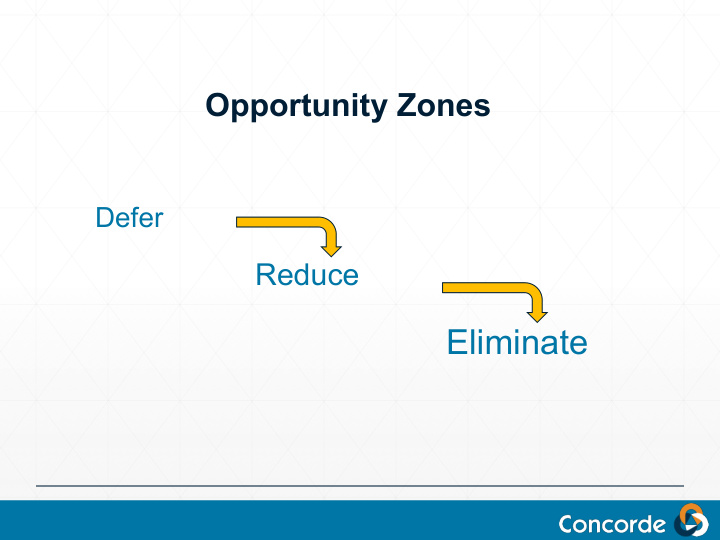



Opportunity Zones Defer Reduce Eliminate
Quiz Question #3 ▪ How many opportunity zones are there? ▪ 693 ▪ 1,031 ▪ 3,460 ▪ 8,700
Opportunity Zones ▪ Part of Tax Cuts and Jobs Act ▪ Timeline ▪ Investor sells asset generating capital gain ▪ Invests gain (all or partial) in a Qualified Opportunity Fund ▪ 10% step-up in basis if invested for five years ▪ Additional 5% step-up if invested for seven years ▪ Deferred gain becomes taxable December 31, 2026 ▪ If QOF investment held for 10 years, no capital gain
I have a client selling investment real estate. Which option is most suitable – a 1031/DST or an opportunity zone fund?
1. What is the client’s basis? 1031 Exchange/DST Opportunity Zone Fund Low basis Significant basis
2. Does the client want to 1031 again? 1031 Exchange/DST Opportunity Zone Fund Investor can 1031 again Taxes due 12/31/2026
3. Does the client need immediate cash flow? 1031 Exchange/DST Opportunity Zone Fund Immediate cash flow Cash flow post development
4. How aggressive is the client’s risk profile? 1031 Exchange/DST Opportunity Zone Fund Stabilized assets Development Risk
5. Is the investor ok with a blind pool? 1031 Exchange/DST Opportunity Zone Fund Fully identified assets May be a blind pool
6. What level of diversification is needed? 1031 Exchange/DST Opportunity Zone Fund Often single asset May be multiple asset fund
7. What are the investor’s return expectations? 1031 Exchange/DST Opportunity Zone Fund Modest IRRs Potentially higher IRRs
8. What is comfort level of compliance risk? 1031 Exchange/DST Opportunity Zone Fund Well established New, significant, developing
9. What is the client’s time horizon? 1031 Exchange/DST Opportunity Zone Fund Potentially < 10 years At least 10 years
Quiz Question #4 ▪ An investor places funds at a QI, IDs replacement property, but decides to not purchase. When does he/she get the money back from the QI? ▪ Immediately upon notification to QI ▪ After a 30-day hold on the funds ▪ 135 days after the end of the ID period ▪ Never – QI buys new boat
10. Is the investors outside the 1031 safe harbor? 1031 Exchange/DST Opportunity Zone Fund Must use QI; 45-day ID No QI; up to 180 days
11. Is the client in a pass-through entity where other investors just want cash? 1031 Exchange/DST Opportunity Zone Fund Drop & swap prior sale Investors not tied together
12. Does a potential OZ client reside in a conforming state? 1031 Exchange/DST Opportunity Zone Fund Irrelevant If no, fewer tax benefits
Quiz Question #5 ▪ In development projects, what could possibly go wrong? ▪ Nothing ▪ Everything ▪ Somewhere between nothing and everything
Development Risks ▪ Construction delays due to factors such as weather and contractor issues ▪ Cost overruns due to increases in prices and unforeseen events ▪ Lease up risk as the project could take longer to lease than expected ▪ Economic risk as a recession may lead to lower demand and lower rents
More Development Risks ▪ Disputes with the city or neighbors ▪ Underground surprises ▪ Financing risk including interest rate risk and the ability to refinance the construction loan ▪ Lack of operating history on which to base projections ▪ Cap rates may be higher in the future than the sponsor’s projections
Opportunity Zone Fund Issues ▪ Many new sponsors ▪ Extremely complex fund compliance ▪ Few OZs are attractive for development ▪ Land prices increasing in OZs ▪ Weak developer due diligence
More Opportunity Zone Fund Issues ▪ Project readiness ▪ Entitlements/permits ▪ Construction financing ▪ GMAX contract ▪ Reasonable projections ▪ Construction costs ▪ Rents, occupancy, expenses ▪ Stress tested ▪ Reserves ▪ Exit cap rates
SCENARIO: HYPOTHETICAL AFTER-TAX VALUE Qualified Traditional Stock Opportunity Fund Portfolio Assumptions: • L-T capital gains rate of 23.8% (federal cap gains 20% + net investment income tax 3.8%) • 7% compounding rate of return both investments Results: • Additional $441,280 in after- tax appreciation Source: • Cantor Fitzgerald
Recommend
More recommend